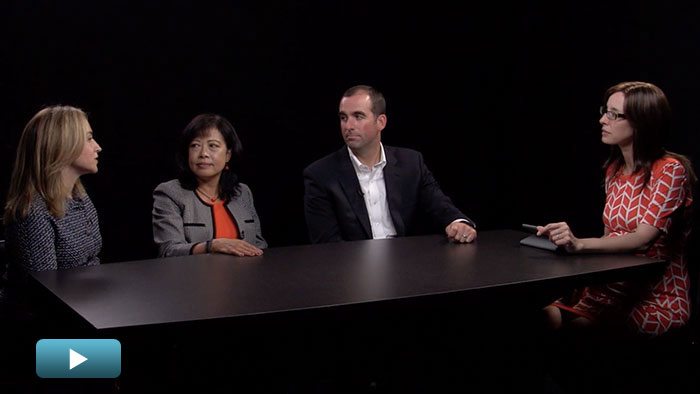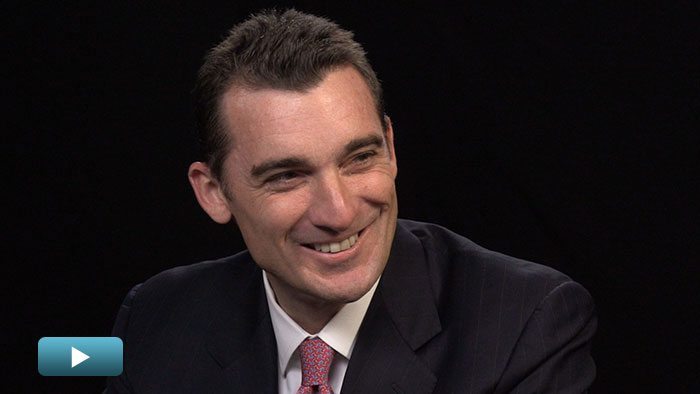Best Structures for Core Investing
Core Real Estate is primarily accessed through open ended funds, but REIT’s and Direct Investments are becoming increasingly more popular, say three experts from NEPC, PREI, and Connecticut State Retirement and Trust Funds.
Transcript Download Transcript
Best Structures for Core Investing
The Evolution of Core
Zoe Hughes, PrivcapRE: I’m joined here today by Cathy Marcus, Global Chief Operating Officer for Pramerica Real Estate Investors; Cherie Santos-Wuest, Principal Investment Officer for Real Estate at Connecticut State Retirement and Trust Funds; and Sean Ruhmann, Director Of Real Assets Research at NEPC. Thank you all so much for joining me today.
All: Thanks for having us.
Hughes: In trying to get to the heart of investing in U.S. core real estate, I would love to get your thoughts as to what are some of the best structures for investors to actually execute on this strategy? It could be through either open-ended funds, separate accounts, directly, joint ventures or (dare I even say it) REIT investments. Sean, kick us off here. Open–ended funds do seem to be the vehicle of choice for most investors. What are you actually seeing? Are you seeing a shift away from open-ended into perhaps more direct JVs or even REITs? Give me your sense.
Sean Ruhmann, NEPC:
I would say the vast majority of our clients access core real estate through open0-nded core funds, primarily. Secondarily—and this is a bit newer, would-be REITs, less so separate accounts or direct investments—that’s partially, for a lot of groups, a size issue, if you’re going to make a $20–million commitment to core real estate and you’re thinking about doing it through a direct investment that limits you to what you can do. We think that changes the risk–return profile of what you’re trying to achieve.
Hughes: There must be huge issues—and I think we’ll get to this—in terms of diversification and trying to get scale and things like that. Cherie, you’re the investor here. How have you accessed core real estate? What’s been the best for you?
Cherie Santos-Wuest, Connecticut State Retirement and Trust Funds: We execute our core strategy either through investing in open–ended core funds…[or] through separate accounts. Our separate–account portfolio comprises about 15% to 20% of our overall core bucket. To that end, we are experiencing exactly what Sean said, which is some difficulty in placing money directly into core real estate when the prices have escalated. We’re not even talking about a $20–million ticket. Our tickets are $30 to $50 million. We’re having trouble placing those even…so we almost need to place leverage on them. That is a very competitive space.
From an asset management standpoint, we’re actually using our open-ended core funds almost as money-market funds. While they are somewhat liquid with redemptions of a quarterly basis, we are able to place monies that are being held in cue for value-add and opportunistic funds, newer commitments in value-add and opportunistic funds within these core funds. And then, shift them incrementally from the core funds as capital is drawn on new commitments.
Hughes: Cherie, you’ve raised a very important point in terms of the redemptions in cues in terms of open-ended funds. One of the pros of open-ended funds is the fact that it’s liquid and you can get access to your money. Give your examples.
Santos-Wuest: Real estate is not liquid. Let’s not fool ourselves. Not even REITs are liquid because the trading really is not as great. The volume of trading is not as great for REITs as you would think—[that’s] my own experience here. However, that said, open–ended core funds—we have no illusions that they are… they have sometimes had redemption cues during the downturn especially. But, by and large, with a stable of a very well-run, open-ended core funds we’ve…not had a lot of issues with redemption. As I said, we’ve placed our money accordingly into core funds, specifically for the income component. And we are able to use this money; we can shift these monies incrementally as needed. During a downturn, where you would think you would have redemption cues, we are satisfied, having experienced the deepest downturn in real estate history for a while, that we are still able to get some incremental measure of stable returns through the income component in our core funds.
Hughes: Cathy, talk about the kind of growth of some of the funds for the open-ended funds. Have you seen a good, strong growth in terms of open-ended? Are you seeing more in separate accounts? How are investors accessing core real estate in the U.S.?
Cathy Marcus, Prudential Real Estate Investors: We’ve seen tremendous growth in the open-ended funds market and I think there have been a lot of mandates given out for separate accounts as well. But clearly it’s much more easily measured when you look at the Odyssey universe. There have been probably 13 or 14 new entrants or about to be entrants in the Odyssey since the first stable group began. Then, there was not much addition for a while, and now there has been a tremendous amount of new participants in the Odyssey. What that tells you is that there is a lot of demand for the product. It’s a product that a lot of managers like to run—it’s very stable and it really gives you entre into larger markets and larger-type products and international investors. Clearly, there has been a lot of growth, which is still evident in the entry cues that exist in a lot of the large funds. And in the fact that they just continue to be not just people increasing their allocations, but also people who are new to the space or maybe new to U.S. core funds. Or new to real estate in general, because often what I’ve seen is that when an investor is making its first real estate investment either in the U.S. or in general, the open-ended core fund space tends to be the training wheels of larger or broader real estate investing. If you want to achieve instant diversification and you want to watch the market a bit and learn a bit, that tends to be where people go first.
Santos-Wuest: Right. I will also say that an important component of that is the mindset behind larger investors in this space, many of whom are lead by presumably a CIO with no real estate background, so they tend to be—if you look at the overall asset, we’re all asset allocators. When you look at the overall asset allocation of many large pension funds, real estate is just a sliver. It’s a small component, 7% to 10%, perhaps as much as 15% in some areas. Much of that portfolio is still public, whether it be fixed income or public equity. The public-markets mentality suits your CIO or whoever is leading the charge on the asset allocation. The core, to the extent that there is some liquidity in open-ended core funds, that tends to be more favorable.
Hughes: Sean, I want to bring you in here. You actually think REITs could be a structure that investors take hold of in terms of accessing U.S. core real estate. How does it work? What would you recommend?
Ruhmann: We do think REITs have a place in the discussion of core real estate. When we think about core real estate, what we’re really thinking about is the underlying asset, the buildings that folks own. Then, we layer on top of that the structure through which you can access those buildings. So, we think about core real estate as a long-term investment as well. It’s not something that is a liquid asset that you can buy and sell every quarter, every year. We think about the hold period of having a much longer duration. When you put those two together, REITs own the same type of properties that you own in your core fund. And a long duration holder when you start to look at those two things together over five to seven–year time periods. Five to seven–year returns for REITs and core real estate are highly correlated. In the short run, REITs do look like small-cap stocks or they are very much volatile and correlated to equities. However, if you extend that hold period to that five to seven years, they actually decouple from equities. They look very much just like regular old core real estate, which makes sense. Because when a REIT sells a building, if you own the building next door, the price of that building sold is going to ripple through your evaluation. Whenever that comes back up again, it will impact your pricing. So, we think they are very much linked together.
Marcus: I think a really important point to note, too, is that a lot of the most coveted assets in the Odyssey—
Ruhmann: Are held by REITs.
Marcus: —Are 50% owned by REITs or more because they’re a venture with an Odyssey fund. So, if you think about that, there is a lot more crossover at the fundamental real estate level than people think about.
Santos-Wuest: No question about that. The question though is: are the REITs who are performing as core Odyssey players actually being rewarded for their good efforts? Our own experience and observations, at least short–term, has been that REITs will correlate as much—it’s a hybrid. It correlates as much with public equities.
Ruhmann: The REIT market cap has grown significantly, so they are very different today. And some REITs have been forced to focus in particular areas. So, if you want New York office exposure, there are REITs that focus in that. If you want suburban office, there are REITs that focus in that. And they trade in different multiples. They trade at different yields and those REITs have bad structures, for some of the laggards that are still externally managed. If you look at those valuations, which those externally managed REITs trade at, they’re very few of them left today. They pay a penalty for doing that, because the market hates the corporate governance. And that works through the share price, so I definitely think there are good REITs and bad REITs and the market recognizes that.
Hughes: Are they truly liquid, in your experience?
Santos-Wuest: Our experience has not been the case, and perhaps it has to do with the actual REIT. We had investments in a private equity fund that REIT-ed, and it took three years for that particular hotel REIT to find its bearings and be in the money again. Then, it still took me another six weeks to sell it, to sell three–and–a–half million shares because the particular REIT was only trading 450,000 shares a day. It wasn’t quite as liquid as I had been led to believe.
Ruhmann: Yeah. I think other reasons why I would say that REITs have a place is some of the properties that have core, like cash flow properties, that REITs offer access to you can’t get largely in Odyssey funds. You mentioned malls earlier. If you want fortress malls, you have to go to the REIT market. And if you are an owner of one fortress mall, you actually are probably operating at a disadvantage, that when they go negotiate their leases with Banana Republic, if you own a whole suite of malls you probably have a lot more leverage than the single mall owner. So, you get outside of the core four food groups—that’s half the REIT market cap. There is another whole half of the REIT market cap that are a variety of asset types that you really can’t get a lot of exposure to if you wanted it through just straight core funds.
Hughes: Are you seeing much innovation in terms of structures?
Marcus: I think the real innovation I see in our space is more on the retail side—not institutional real estate necessarily, but I think retail is going to be the wave of the future. And a lot the broker-dealers… high net-worth distributors or aggregators are trying to figure out how to get direct real estate into their clients’ investment portfolios. When you think about the shift in this country from defined benefit to defined contribution, if you think ahead 10 or 15 years, it’s not hard to see a real growth in the retail market. So, all the structures that need to be created or modified in order to enable that, like some of the changes happening with the private REIT market and trying to make that more transparent, which mostly caters to the retail investors.
Santos-Wuest: Would that be considered core, though?
Marcus: You can have a core strategy for an institutional or retail investor. Again, how do you access direct real estate in one of those? You have to be a pretty large strategy or fund of funds, which I think are probably going to be a bit more prevalent in that space. Then, outside the U.S., interesting new fund structures. Not so much new, but becoming more popular like use its, etc., I think are…the innovations that I’m seeing.
Hughes: Sean, what innovations are you seeing in the market?
Ruhmann: I would echo a lot of what you said, specifically regarding DC plans. I think most every large open–end core manager out there is thinking about some way to build a daily value, daily liquidity option that can attract DC plans. There are a few that have gotten off the ground and have AUM. I think the vast majority of others are thinking about how to do that and that’s also trying to blend into more opportunistic strategies. Looking forward 10 to 15 years and thinking about how people are saving for retirement—that is certainly shifting. So, if you’re running a larger opportunity fund, you’re probably trying to think about ways you might be able to access some of that capital. Another thing I think a lot of our institutional clients are thinking about is just the fee element—how to change structures to make the fees a bit more attractive.







